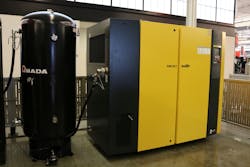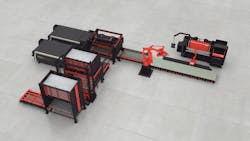DUSTIN DIEHL
As fiber laser technology has rapidly advanced over the last several years, it can be hard to distinguish what is important when considering a high-power fiber laser. There are more things to consider than the highest kilowatt rating or the fastest advertised feed rates. Putting an entire package together for your success involves many areas of evaluation. Some of these for consideration may include kilowatt ratings and feed rates, but should also address assist gas cutting solutions, cost per part, automation, and expansion for future growth.
For many years, the industry standard was based upon the most-common laser wattage sold throughout the late 1990s and 2000s—that being in the range of a 4 kW carbon dioxide (CO2) laser. Yes, there were some higher machine ratings available, but the most common were in this range. The progression of CO2 technology spanned almost 30 years and leveled off for many of those years, and wattages never increased much above the 6 kW range. This is in large contrast to what we have seen with the evolution of fiber laser technology.
High-power fiber laser advantages
While fiber lasers were introduced in the mid-2000s, the market did not gain much traction until 2010 or 2011. This is when the laser cutting industry started to see all major machine manufacturers introduce their products with confidence that this technology was capable of being a viable production tool with many benefits.
In early releases, these first lasers had power ratings between 2 and 4 kW. In just a few short years, these ratings have quickly doubled or even tripled. With the rapid advancements in fiber laser technology, there are many factors to consider. For example, what is it that is best for your production needs? Putting an entire package together to best meet the needs of your manufacturing can be challenging.
With higher-wattage lasers come many advantages, including increased productivity and throughput as well as lower cost of operation per hour and energy efficiencies. One area that may be overlooked while enjoying these benefits is the consumption of nitrogen while cutting mid-thickness materials where gas volume and pressures are required. This is an area where looking further into the processing of the part through different cutting techniques can also help you reduce the cost per part.
Cutting with nitrogen
With the evaluation of nitrogen generation systems, optimized nozzle techniques, nitrogen purity levels, and assist gas pressures, good edge quality and lower cost per part can also be another benefit. Applying these techniques could result in a 20–30% increase in feed rates with as much as a 70% reduction in the consumption of assist gas vs. conventional nitrogen cutting.
Nitrogen cutting is generally the preferred method of cutting materials that fall within its processing range. This is compared to oxygen cutting with its exothermic reaction, which leaves an oxide edge that must be removed in downstream processes. Nitrogen is the preferred method because it allows for the reduction of these secondary operations and allows product to flow directly to powder coating or welding.
In-plant nitrogen generation may be applicable for users that are looking for a simple solution to eliminate oxidation in thin material and do not require high-purity nitrogen. Amada’s N2 generation systems provide clean, dry nitrogen for cutting, or can also be used with a gas mixer to allow even more options for material processing (FIGURE 1).
Assist gas selection
When it comes to the selection of assist gases for the application, there are advantages in the mixing of these assist gases to create the perfect environment for different materials. This is done by adding a gas mixer inline from your existing oxygen and nitrogen supply and then providing this blend into the machine for yet another solution for better edge quality and dross-free processing.
For example, often in laser-cut aluminum, the edge quality is not acceptable without a secondary deburring process. Dross-free aluminum fiber laser cutting can be achieved by introducing small amounts of oxygen into the cutting process. A mix of gases allows a good combination of improving the cut quality while keeping the weldability and powder coating applications free of any secondary process.
Adding a gas mixer can also benefit the cutting of mid-thickness mild steels. This range may include 11-gauge, 7-gauge, 1/4 in., and 3/8 in. materials that were previously cut using oxygen with a CO2 laser. Now with the advantages of high wattage fiber lasers, these materials can be cut with nitrogen or, better yet, with a mix of gases. As previously mentioned, this can result in a 20–30% increase in feed rates with as much as a 70% reduction in the consumption of assist gases, compared to conventional fiber nitrogen cutting. This advanced cutting solution is achieved through nozzle techniques as well as gas purity levels and flow rates.
How to choose an automation system
Choosing your automation wisely is important to round out your entire package and maximize green-light-on time. With high-speed cutting resulting in much lower nest cycle times, the speed of the automation is now more relevant than previous CO2 cycle times. When considering the automation that best fits manufacturing demands, both current and future needs should be evaluated. The best solution for automation is a system that is flexible. Flexibility will allow you to configure a system to take full advantage of your fiber laser, as well as expand and grow with the business.
In earlier automated cells containing lasers, cycle times were in excess of 3–4 minutes and the speed of the automation was not as big a factor as it is currently. Fiber lasers can create nest cycle times that challenge the automation to have the next sheet presented to the laser, ready to cut in <1 min. To achieve these fast automation cycle times, it requires the system to perform many tasks simultaneously.
For example, the system will be both unloading a previously cut nest from one shuttle table while picking up the next sheet from the raw material stack to immediately replace the unloaded nest. This allows the laser to simply exchange cutting pallets and continue processing the nests without waiting on the automation to present the next sheet (FIGURE 2).Material storage
Another automation area that should meet your demands is material storage. Is a single shelf of raw material acceptable? Do you require the storage of multiple materials to be readily available to schedule through your fiber laser? These questions are often easier for a large OEM that can forecast production needs further into the future than a job shop that may not know when the next hot job will need to be produced. These two different scenarios can be addressed with the same flexible base automation system. The job shop may have an initial need for automation to maximize production during the off-hour shifts and only require one pallet of raw material to be staged for the laser.
The OEM or even larger job shops may require a storage system that is capable of presenting multiple materials to the laser at any time. Starting off with a system that is flexible and can be added to at any time will prepare you for whatever the future may bring your way.
DUSTIN DIEHL ([email protected]) is laser division product manager at Amada America, Buena Park, CA; www.amada.com/america.

